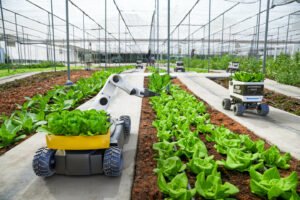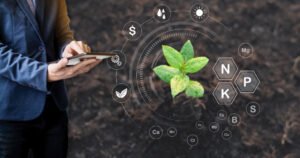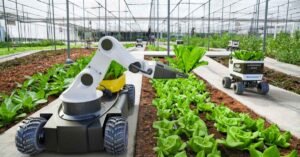There is a green revolution happening in agriculture, and agriculture is constantly changing. Solar farming options show the way forward. As the world grapples with climate change and looks for long-term solutions, harnessing the power of the sun has become a sign of hope for farmers. This article discusses the many applications, benefits, and bright future of solar agriculture. It shows how this new way of farming is changing the way we work the land.
What Does Solar Agriculture Mean?
1. Use Solar Energy
Solar energy is used in photovoltaic (PV) cells, which are at the heart of solar agriculture. These panels absorb sunlight and convert it into electricity. They provide clean, renewable energy for many agricultural tasks. When solar panels are installed in the right place on a farm, they become silent, sustainable power plants.
2. Solar Irrigation System
Using solar energy for watering is one of the most important. These systems use solar energy to power water pumps, which is more environmentally friendly than standard pumps that use fossil fuels. Solar irrigation not only reduces costs but also helps save water, which is important to consider in sustainable development.
3. Off-Grid Energy Generation from Solar Energy:
Off-grid solar energy solutions are the best way to power homes and businesses in remote areas without easy access to the electrical grid. Lighting, refrigerators, and communications equipment can all be powered by these systems. This gives farmers the tools they need to grow in an efficient, modern way, even though they are not far from a traditional energy source.
Benefits of Solar Agriculture:
1. Cost Savings and Other Financial Benefits
One of the best things about growing with solar energy is that it saves you money. The initial cost of installing solar panels may seem high, but they will save you money on your energy bills in the long run, government incentives may be available, and you can even sell excess energy back to the grid.
2. Protect the Environment
The use of solar energy is in line with the idea of protecting the earth. Solar agriculture helps reduce greenhouse gas emissions by reducing the need for fossil fuels. This illustrates the impact of agriculture on climate change. This approach is better for the environment and will make the agricultural sector stronger and more sustainable.
3. Own Your Energy
Solar gardening offers farmers some freedom in their energy needs. Farmers are less affected by changes in energy prices and supply chain issues when they generate their electricity. This freedom enables farmers to meet their energy needs in an environmentally friendly and efficient way.
Bringing Solar Energy Solutions to the Farm:
1. Solar Water Pumps
The use of water-pumping equipment powered by the sun is a big step forward. These devices use solar energy to pump water from wells or other locations to water crops. They are flexible enough to change based on the water needs of different plants and work best in a sunny location.
2. Solar Energy Devices Connected to the Electricity Grid
Grid-tied solar systems can be installed by farmers connected to the electricity grid. The solar screens in these systems generate electricity and if more is generated than necessary, they can send it back to the grid. In some places, farmers can receive credits for additional energy, further reducing electricity costs.
3. Solar Greenhouse
Greenhouses are important to modern agriculture because they extend the growing season and protect plants from harsh weather conditions. Adding solar energy to a greenhouse can provide the energy needed for lighting, temperature control, and watering plants, making the grow space self-sufficient and energy efficient.
Questions and Things to Think About:
1. Initial Investment and Financing
One of the biggest problems for farmers considering going solar is the initial investment they have to make. The long-term benefits are enormous, but some farmers may not have access to the financing they need or benefit from government incentives.
2. Turn Solar Energy On and Off
Solar energy depends on sunlight, which can vary throughout the day and the year. To address the interruptions, farmers may need to use energy storage devices, such as batteries, to save additional energy when sunlight is scarce.
3. Technical Knowledge and Maintenance Knowledge
To set up, monitor, and maintain a solar energy solution you need some technical knowledge. Farmers can take good care of their solar equipment with the help of training programs and support services.
Future Trends and Inventions:
1. Solar-Powered Self-Propelled Machine
The future of solar farming may include the addition of self-driving machines powered by sunlight. From solar-powered tractors to self-driving drones, these new technologies can make farming more efficient and less damaging to the environment.
2. Solar Desalination to Ensure Sufficient Water
Solar desalination technology could be a long-term solution for water-scarce areas. These systems use solar energy to remove salt from seawater, making it a sustainable water source for plants.
3. Community Solar Energy Projects
As part of a community solar project, a group of farmers invest in and benefit from solar installations. These projects can reduce the cost of each investment, encourage people to work together, and make solar farming options more common.
Conclusion:
Solar farm tools are a bright spot in the future of safer, greener agriculture. As technology continues to advance and the world battles climate change, solar energy is becoming an important tool for farmers looking to protect the environment and ensure the longevity of their businesses. Farmers are harnessing the power of the sun to not only light up their farms but also make the future brighter, greener, and stronger.
FAQs:
1. How do solar farming solutions work? What are their main applications in agriculture?
Solar farming solutions use sunlight to generate electricity through photovoltaic panels. The main applications are diverse and include powering irrigation systems, pumping water, greenhouse operations, and powering essential agricultural equipment.
2. What are the economic benefits to farmers of adopting solar energy solutions? How do these benefits outweigh the initial investment costs?
In the long term, farmers who adopt solar energy solutions can realize cost savings, including lower electricity bills and potential revenue from selling excess energy to the grid. Government incentives and financing options can help offset the initial investment costs.
3. Can solar farming solutions be implemented in areas with less sunlight or on cloudy days?
Although solar energy works best in sunny areas, modern solar technology can still work efficiently on cloudy days. Additionally, using energy storage solutions such as batteries can help address intermittent issues and ensure continuous power supply.
4. What challenges do farmers face in adopting solar energy solutions? How can these challenges be mitigated?
Challenges include initial investment costs, the variability of solar energy, and the need for technical knowledge. Farmers can meet these challenges by exploring financing options, implementing energy storage solutions, and participating in training programs to improve technical skills.
5. How does solar agriculture contribute to environmental sustainability? What impact does it have on reducing greenhouse gas emissions?
Solar agriculture is environmentally sustainable by reducing dependence on fossil fuels. It helps reduce greenhouse gas emissions associated with conventional energy sources, mitigates agriculture’s impact on climate change, and promotes a more environmentally friendly agricultural sector.



